Since I am attempting to revitalize my 401's, I am wondering if I should take it a leap further by stripping off the wood-grain vinyl to sand and then painting them for personalization. I have a heat gun to facilitate the vinyl removal. I realize that this modification will destroy their authenticity, but it's not they are a pair of Monitor Audio Gold 300's! Opinions.....suggestions are welcome.
Hey, I own a pair of these! Wait.....you were referring to me, weren't you? Do you need a photo of the connection on the driver/woooofer?When I said "If only we knew someone who owns a pair of these speakers and could reveal to us all of the wiring and components!", THAT was a joke (referring to the OP)!

Hey, I own a pair of these! Wait.....you were referring to me, weren't you?
I was, and still waiting with baited breath to see photos of the components in series with the tweeter so I can help you test if any are faulty.
Do you need a photo of the connection on the driver/woooofer?
No, we've already got enough photos of the drivers and the general wiring arrangement.
P.S. Have you actually removed the stuffing yet?
OK, here is what I have so far. The capacitor and bulb fuse are located against the inside rear of the cabinet. The cap is hot glued to the wall but looks like it can easily be removed. The bulb fuse is wire-wrapped pretty tightly to the terminal. It looks to me that the bulb fuse is OK. Should I remove the capacitor to test it? I do not have a replacement yet because I wanted to check the exact rating from the original.
I do not see the resistor, though!
It is going to be difficult getting my soldering iron in there while holding the new capacitor in place for attachment. Any suggestions on how to do this replacement?
After pulling back more of the filler from the capacitor, I uncovered the wire-wrapped resistor (I assume that is what it is); one end is connected to the cap, and the other end is connected to the grey wire.
If that is the wire-wrapped resistor, do those go bad? Should I replace it as well as the capacitor?
The small piece of paper is the sticker that is attached to the rear of the front-facing woofer/driver.
I do not see the resistor, though!
It is going to be difficult getting my soldering iron in there while holding the new capacitor in place for attachment. Any suggestions on how to do this replacement?
After pulling back more of the filler from the capacitor, I uncovered the wire-wrapped resistor (I assume that is what it is); one end is connected to the cap, and the other end is connected to the grey wire.
If that is the wire-wrapped resistor, do those go bad? Should I replace it as well as the capacitor?
The small piece of paper is the sticker that is attached to the rear of the front-facing woofer/driver.
Attachments
-
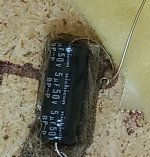 20240330_125830.jpg282.6 KB · Views: 37
20240330_125830.jpg282.6 KB · Views: 37 -
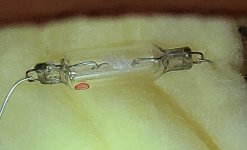 20240330_125721.jpg190.4 KB · Views: 36
20240330_125721.jpg190.4 KB · Views: 36 -
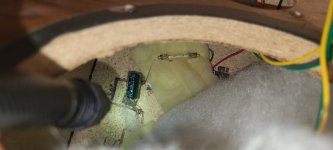 20240330_125646.jpg198.4 KB · Views: 38
20240330_125646.jpg198.4 KB · Views: 38 -
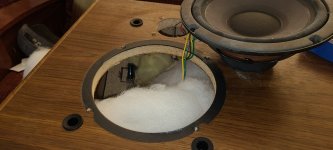 20240330_125542.jpg307.5 KB · Views: 35
20240330_125542.jpg307.5 KB · Views: 35 -
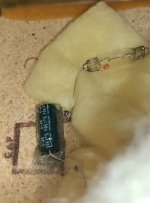 20240330_125451.jpg341.8 KB · Views: 31
20240330_125451.jpg341.8 KB · Views: 31 -
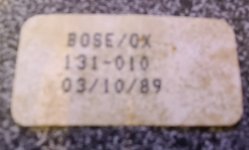 20240330_131906.jpg155.7 KB · Views: 33
20240330_131906.jpg155.7 KB · Views: 33 -
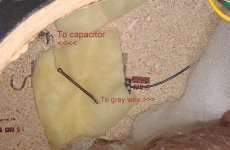 20240330_131557.jpg176.4 KB · Views: 30
20240330_131557.jpg176.4 KB · Views: 30 -
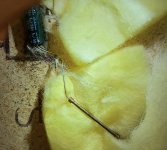 20240330_131432.jpg653 KB · Views: 38
20240330_131432.jpg653 KB · Views: 38
Last edited:
May be I'm wrong, but just looking at them, it seems to me the capacitor is quite like new, even too new (could it have already been replaced by the previous owner?) and the lamp broken.
However, in order to re-solder a components I think you would first have carefully detach it from the panel reattaching it after resoldering. IMO
Edit to add: the lamp seems good, in the first pic there is a white spot on the glass which misled me.
However, in order to re-solder a components I think you would first have carefully detach it from the panel reattaching it after resoldering. IMO
Edit to add: the lamp seems good, in the first pic there is a white spot on the glass which misled me.
Last edited:
@ulogon I also thought the bulb fuse was blown, but it looks as though that spot on it is something that is stuck to the glass. I can scrape it with my fingernail. I have no idea if the previous owner replaced the original capacitor(s), and I don't know the brand that Bose would have used at manufacture. I have been reading that, ideally, a cap should be removed for proper testing. But I would hate to do that and have to reattach it should it be good.
Edit---- Looking closer at that capacitor, I believe it is the original because it is tightly wire-wrapped to its connections just like the other wire connections.
Edit---- Looking closer at that capacitor, I believe it is the original because it is tightly wire-wrapped to its connections just like the other wire connections.
Last edited:
I fully agree with this.But I would hate to do that and have to reattach it should it be good.
Good point.Edit---- Looking closer at that capacitor, I believe it is the original because it is tightly wire-wrapped to its connections just like the other wire connections.
Is this dark green colour like these (please read the Bose related notes in the description)?
Also please remember the following comment
However, I don't remember if you have already been advised to exchange the tweeters (and/or the woofers) between the two loudspeakers to detect if there were differences in drivers or in crossovers (capacitors).Personally, without a way to measure said capacitor, I wouldn't just throw parts at it.
A lot of what your hearing is the woofers. One or more of those could be compromised. The tweets are usually crossed fairly high.
Edit to add: anyway let's wait to hear @Galu 's opinion too because I would not want to seem unkind...
Last edited:
Yep, those look like it but I need axial, and 5uf.@ulogon Is this dark green colour like these (please read the Bose related notes in the description)?
I am unable to spend any extensive sheckles on these right now. I was hoping that a $1-$2 capacitor was all that they needed since they are 35 years old!
No no no, it wasn't to tell you to buy them, but just to have a further clue regarding the hypothesis that it is original.Yep, those look like it but I need axial, and 5uf.
I am unable to spend any extensive sheckles on these right now. I was hoping that a $1-$2 capacitor was all that they needed, being 35 years old!
Should I remove the capacitor to test it
It's a good quality 5 uF Nichicon NP electrolytic capacitor as originally fitted and is unlikely to be out of spec by any significant amount.
I uncovered the wire-wrapped resistor (I assume that is what it is)
That's an unusual wire wound resistor, but as long as its up to the job...
Could you measure the resistance of both the lamp and the resistor and report back your readings?
EDIT: Remember to subtract the resistance of your multimeter leads from the total reading.
Last edited:
The cap is hot glued to the wall but looks like it can easily be removed.
As I said earlier, I believe the capacitor is sitting on a damping pad.
What about either of these?
Not those as they appear to be polarised types. Check the Datasheet.
You need a bipolar (non-polar or NP) type - usually available as 4.7 uF which would be just fine.
Last edited:
Everything looks fine. If it had been really overpowered, that resistor would have shown it. That one looks fine.
You can test the lamp by hooking up the speaker and playing some music, doesn't have to be loud. With the speakers sitting out (maybe set the woofer on a towel) flick the lamp with your finger and listen to the tweeter for it to cut out. If it doesn't, all good.
Again, HIGHLY doubt the cap is bad.
You can test the lamp by hooking up the speaker and playing some music, doesn't have to be loud. With the speakers sitting out (maybe set the woofer on a towel) flick the lamp with your finger and listen to the tweeter for it to cut out. If it doesn't, all good.
Again, HIGHLY doubt the cap is bad.
you keep wanting to pull the cap to test it, so you must have some means to do so, don't you?
Good question!
I think I am correct in saying that at no point in the thread has SpineyNorman indicated he has a meter, let alone one that measures capacitance and ESR.
I have asked for resistance readings of protection lamp and series resistor - if only for the record. We'll see if they are forthcoming.
A good quality Nichicon NP electrolytic capacitor is fitted, but it is now 37 years old. However, a small departure from the original capacitance and ESR values may not be too significant in the context of this 1st order HF filter - so SpineyNorman may simply decide to leave it in circuit.
If it were me, I would put a fresh capacitor in as a matter of course - especially since I'd gone to all the trouble of opening up the loudspeaker.
so if age is a factor just how does one know how old a capacitor is?
how long was it sitting in the vendors inventory...etc...
when it comes to lytics i'll always put them through some "forming" before measuring value for some assurance of a good part.
i guess we'll have to stand by and see what SpineyNorman does....
how long was it sitting in the vendors inventory...etc...
when it comes to lytics i'll always put them through some "forming" before measuring value for some assurance of a good part.
i guess we'll have to stand by and see what SpineyNorman does....
- Home
- Loudspeakers
- Multi-Way
- Information request for modifying Bose 401s